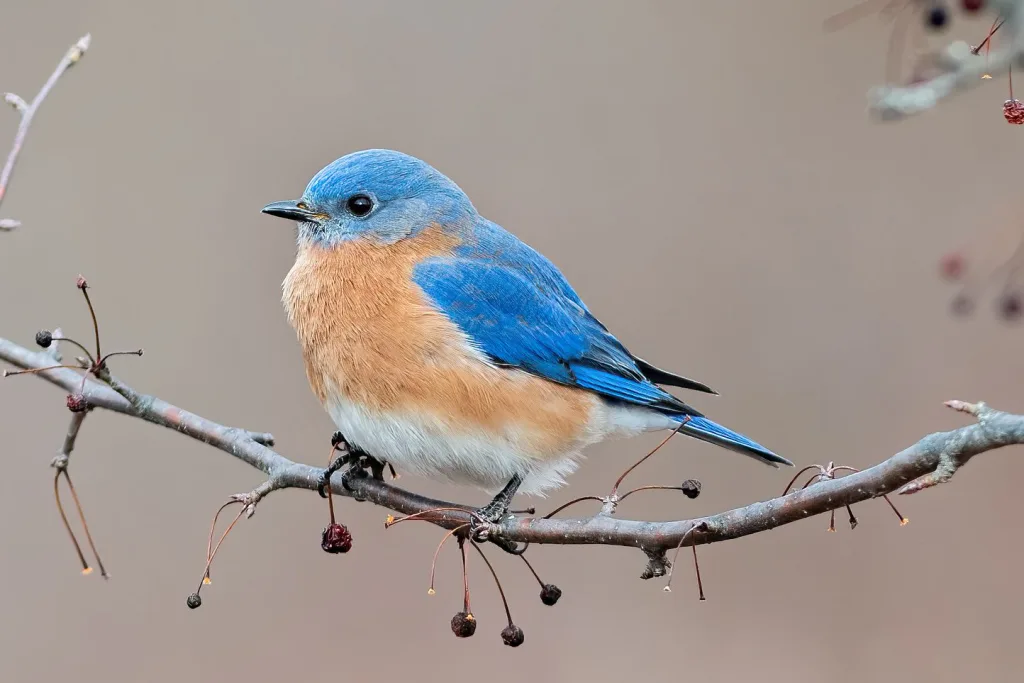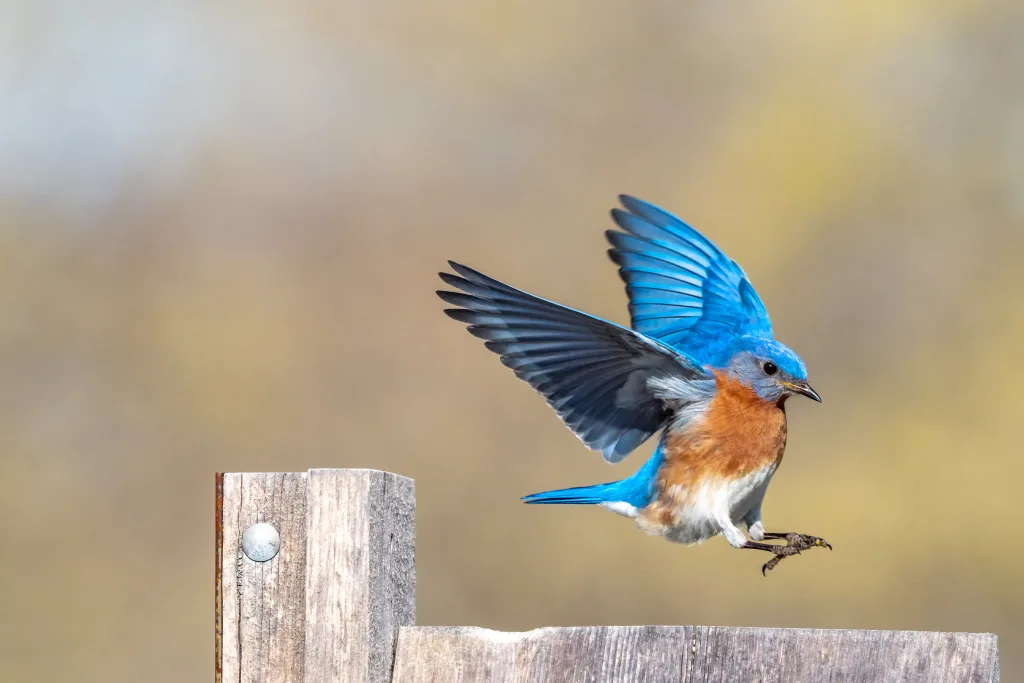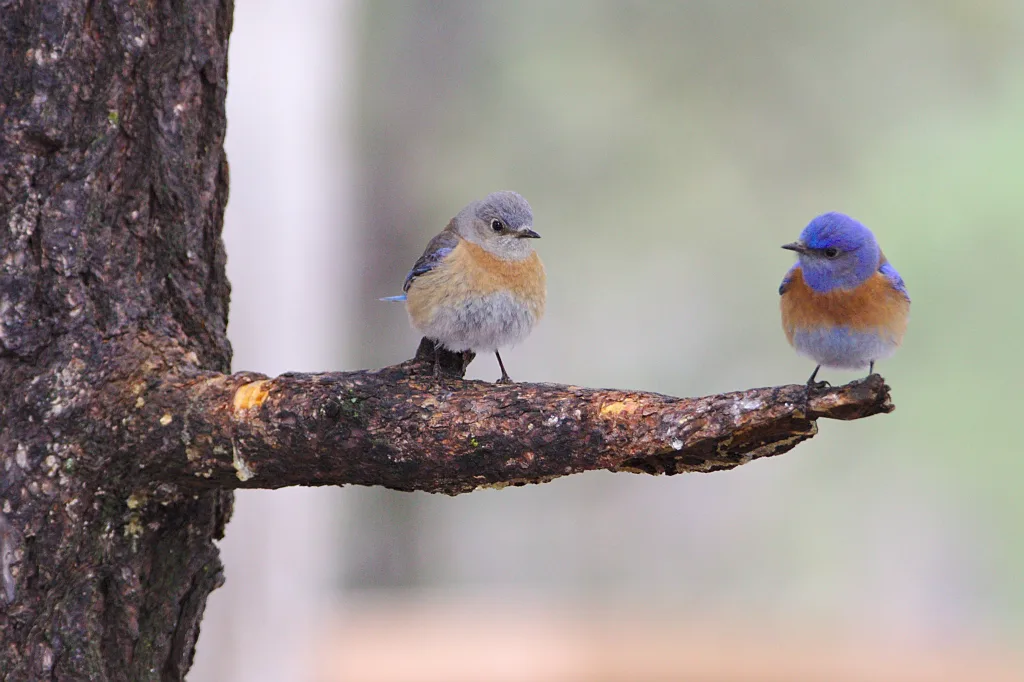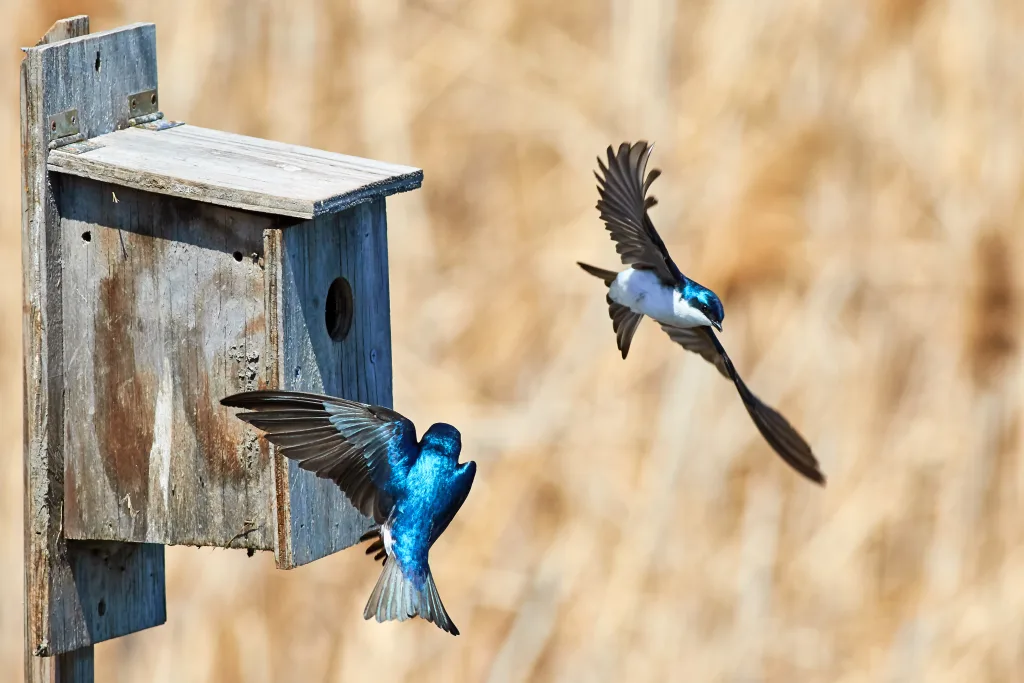If you are an outdoor enthusiast living in Michigan, bluebirds are a bird you should definitely be familiar with. These birds are not only beautiful but also incredibly beneficial to their environment.
Eastern bluebirds are a common sight in Michigan’s southern counties throughout the year. Male eastern bluebirds measure between 6 1/2 – 7 inches long and have bright blue coloring on their back, forehead, crown, shoulders, wings, and tail. Along with this bright blue coloring is faint black and white barring that can be seen in the wing primaries.
Bluebirds begin scouting out nest boxes as early as late February or even earlier in the south and if conditions remain favorable they may continue nesting into August or September. Studies have shown that anywere from 26% – 44% of adult bluebirds return to breed at the same site where they nested the previous year so there is a good chance that if you attract these birds to your yard one year they will come back again!
If you would like to attract these beautiful birds to your backyard there are some simple steps you can take. The most important being installing a bluebird nesting box five to six feet off the ground in an open area. Additionally, providing food such as mealworms, suet balls or seed consisting all or in part of sunflower chips along with providing water in the form of a small pond or bird bath will help make your yard even more attractive to these birds.
So if you live in Michigan and want some extra beauty around your home then consider inviting some Eastern Bluebirds into your backyard!
Attracting Bluebirds in Michigan
To attract bluebirds in Michigan, you should install a bluebird nesting box in your backyard. The nesting box should be placed in an open area five to six feet off the ground. You can also prvide food such as meal worms, suet balls or sunflower chips. Additionally, providing a small pond or bird bath can also help attract bluebirds to your yard. Bluebirds thrive on insects, so make sure there are plenty of insects around for them to eat. Planting native shrubs and wildflowers can also help attract the birds and provide cover for them to nest in. Lastly, it’s important to keep cats away from the nesting area since they can easily prey on eggs and young birds.

Types of Blue Birds Found in Michigan
The Eastern Bluebird is a common resident in most southern counties of Michigan all year round. It is a small, colorful bird that measures 6 1/2 to 7 inches in length and has a bright blue back, forehead, crown, shoulders, wings, and tail. The wings also have very faint black and white barring on the primaries. They are active during the day and feed mainly on insects and fruit. These birds form lifelong pair bonds and nest in cavities or nest boxes provided by humans.
When Do Bluebirds Appear?
Bluebirds are most commonly seen during the spring and summer months, typically from late February to August or September. In the southern United States, they may arrive even earlier in February. During this time, bluebirds can be seen scouting out nest boxes, gathering nesting materials and building their nests. During the breeding season, males will oftn be seen displaying courtship behaviors such as singing to attract a female mate. Once a pair has formed and eggs have been laid, female bluebirds will remain in the nest to incubate her eggs while males keep watch over the nest area and gather food for their young. As chicks hatch and fledge from the nest, bluebirds can be seen feeding their young around your yard throughout the summer months before they migrate south in late August or September.
Do Bluebirds Return to the Same Nest Yearly?
In general, adult bluebirds do tend to return to the same nest year after year. Studies have found that between 26-44% of adult bluebirds will come back to the same nest they used the previous year. This means that there is a good chance (around one in three) that the bluebirds you have in your nest box this year will return to the same box next year. It should be noted, however, that these figures are averages and there can be some variability depending on environmental factors such as food availability and weather conditions.
The Benefits of Having Bluebirds Around
Yes, bluebirds are great to have around! They are beautiful native birds that bring a lot of charm to any outdoor space. Their sweet song and bright colors make them a joy to watch. Plus, they eat insects, so they can help keep pesky bugs in check. But most importantly, bluebirds need our help. Their population has been declining due to loss of habitat and lack of food sources, so providing them with a safe environment is vital to their survival.

The Significance of a Bluebird Visiting You
A bluebird visiting you is said to represent joy, hope, and good news. It is also a sign of spiritual connection to those who have passed away. This symbol has been used for centuries in various cultures and is associated with many positive messages. For example, some believe that it signifies the arrival of a new beginning or the potential for something great in your life. Others view it as a reminder to appreciate the simple things in life and look on the bright side. Seeing a bluebird can also be interpreted as a sign to remain open-minded and optimistic during times of difficulty, as they are known to bring optimism and cheerfulness.
Attracting Bluebirds to Your Yard
Attracting bluebirds to your yard is relatively easy! The first step is ensuring there are plety of places for them to nest and roost. Setting up an appropriate birdhouse, with a hole just large enough for a bluebird, should do the trick. Additionally, providing ample food sources will draw them in. Bluebirds primarily feed on insects and spiders but in winter months they supplement their diet with berries and fruit from trees and shrubs. Planting native trees such as junipers, dogwoods, sumacs, hollies, serviceberries and elderberries can help attract bluebirds all year long. Providing water sources nearby can be beneficial as well – birdbaths or shallow dishes of water may encourage them to stick around. Finally, keeping cats away from the area is essential; cats are one of the main predators of bluebirds so it’s important to protect them by keeping felines out of the area.
Do Bluebirds Migrate to Michigan for the Winter?
Yes, some bluebirds do stay in Michigan during the winter. While most Michigan bluebirds migrate south when the weather gets colder, a few are able to survive mild winters here. They typically return in small flocks from southern wintering grounds and start nesting early, looking for woodpecker holes and cavities to make their homes. If necessary, they will also clean out existing holes or cavities.
Where Do Bluebirds Spend the Winter?
Bluebirds in the northern part of their range migrate south each winter to spend the colder months in the southeastern United States or Mexico. During this migration, some bluebirds fly as far as 2,000 miles from western Manitoba to Texas. Bluebirds typically leave their breeding grounds in the north of their range and arrive in the southeast just before winter sets in. Once there, they stay until temperatures warm up once more in spring.

Creating a Home for Bluebirds: What Type of Birdhouse is Best?
Bluebirds prefer bird houses with an entry hole about 1 1/2 inches in diameter for eastern and western species, and 1 9/16 inches for mountain bluebirds. The floor should be between 4 1/2 to 5 1/2 inches square and the floor should be 5 to 8 inches below the entry hole. Additionally, the house should have ventilation holes at the top, drainage holes at the bottom, and a roof that overhangs slightly to keep out rain. Positioning your bluebird house in an open area away from trees or shrubs is ideal, as this will help protect your birds from predators.
The Ethics of Looking Inside a Bluebird Box
Yes, it is OK to look in a bluebird box. However, it is important to be respectful and cautious when doing so. Make sure to check the box no more than once a week and never during nesting season (April-August). When checking the box, be sure to open it from either the side, front, or top. This will alow you to observe the birds without causing them alarm or stress. Finally, make sure to close the box securely after each inspection. By following these guidelines and monitoring your bird box responsibly, you can help ensure that your bluebird population remains healthy and thriving for years to come!
Do Bluebirds Use Their Houses During Winter?
Yes, bluebirds will use their houses in the winter to stay warm. They are one of the few species of songbirds that will use a roost box in order to find shelter from the cold temperatures. Roost boxes provide insulation and protection from the wind, which helps the birds maintain their body heat. In addition to bluebirds, other species such as chickadees, titmice, screech owls and some woodpeckers also use these boxes during winter months.
Facing Direction for a Bluebird House
When installing a bluebird house, it’s important to consider the direction you face the entrance hole. The ideal direction is eastward, towards open habitat, as this will give the birds more protection from prevailing winds and potential predators. To further reduce competition from other birds like Tree Swallows, you can also position your nest boxes about 15-20′ away from each other and 300′ away from other pairs of houses. This will create a better environment for bluebirds to thrive and raise their young.

Life Expectancy of Bluebirds
The life expectancy of Eastern bluebirds is around 6 to 10 years, although they can sometimes live longer. The oldest known wild individual lived 10 years and 5 months. Unfortunately, mortality rates are especially high in the first year of life, so it is common for the average lifespan to be much shorter than this.
Do Parents Feed Baby Bluebirds?
Yes, both parents feed baby bluebirds. After hatching, the chicks are blind and naked, so they rely on their parents to provide them with food. The diet of a baby bluebird consists mostly of proteins, which are obtained from insects. Both parents take turns finding and gathering food to feed the young birds. They bring the food back to the nest and feed it directly to the chicks until they are old enough to venture out on their own.
Conclusion
In conclusion, bluebirds in Michigan are becoming increasingly more common and can be found in most southern counties. They have bright blue backs, foreheads, crowns, wings, and tails with very faint black and white barring on their wings. Bluebirds typically begin scouting for nesting boxes as early as late February and may continue to nest throuh August or September. Moreover, research has shown that approximately 26-44% of adult bluebirds return to breed at the same site where they nested the previous year. To attract bluebirds to your backyard, you can install a nesting box five to six feet off the ground and provide them with food such as meal worms, suet balls or seed consisting all or in part of sunflower chips along with a small pond or bird bath.
